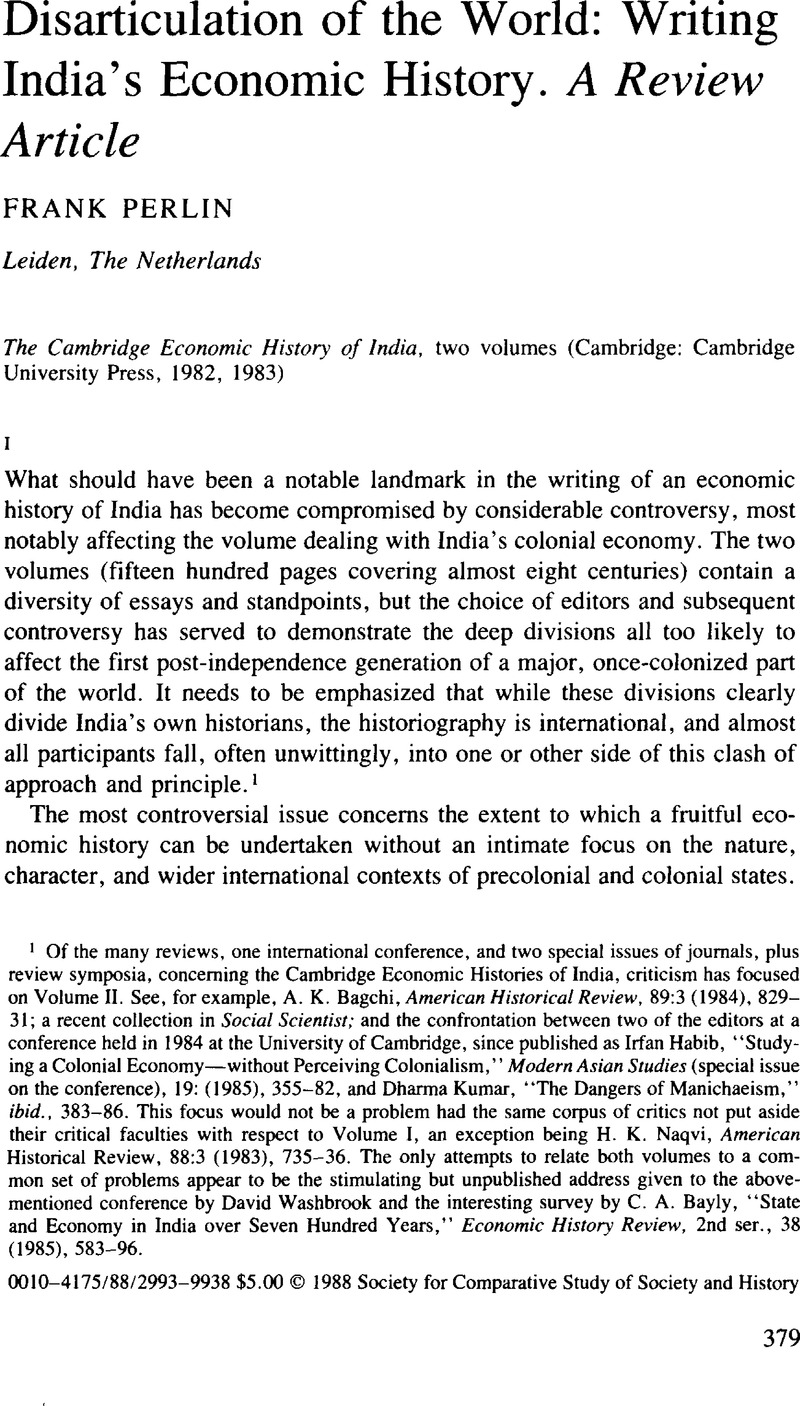Published online by Cambridge University Press: 03 June 2009

1 Of the many reviews, one international conference, and two special issues of journals, plus review symposia, concerning the Cambridge Economic Histories of India, criticism has focused on Volume II. See, for example, Bagchi, A. K., American Historical Review, 89:3 (1984), 829–31CrossRefGoogle Scholar; a recent collection in Social Scientist; and the confrontation between two of the editors at a conference held in 1984 at the University of Cambridge, since published as Habib, Irfan, “Studying a Colonial Economy-without Perceiving Colonialism,” Modern Asian Studies (special issue on the conference), 19: (1985), 355–82CrossRefGoogle Scholar, and Dharma Kumar, “The Dangers of Manichaeism,” ibid., 383–86. This focus would not be a problem had the same corpus of critics not put aside their critical faculties with respect to Volume I, an exception being Nagvi, H. K., American Historical Review, 88:3 (1983), 735–36Google Scholar. The only attempts to relate both volumes to a common set of problems appear to be the stimulating but unpublished address given to the above-mentioned conference by David Washbrook and the interesting survey by Bayly, C. A., “State and Economy in India over Seven Hundred Years,” Economic History Review, 2nd ser., 38 (1985), 583–96.CrossRefGoogle Scholar
2 Because of difficulties in putting the volumes together, many contributions were apparently written up to ten, even fifteen years before publication. Nevertheless, in no case, to my knowledge, has an author retracted or otherwise qualified the positions taken in his or her contribution; instead many contributors have defended their essays, often “vigorously.”
3 “The program of the Enlightenment was the disenchantment of the world; the dissolution of myths and the substitution of knowledge for fancy.” Horkheimer, Max and Adomo, Theodor W., Dialectic of Enlightenment (London: Allen Lane, 1973), 3.Google Scholar
4 Although scepticism of established positions has grown during the last ten years in work unregistered by either volume, this has not been marked by an opening towards the outside world; viz. the criticism in Metcalf, Thomas R., “Rural Society and British Rule in Nineteenth-Century India,” Journal of Asian Studies, 39: (1979), 118–119CrossRefGoogle Scholar; Washbrook, David, Times Literary Supplement, no. 4303 (20 09 1985), 1042Google Scholar; and my “Proto-industrialization and Precolonial South Asia,” Past and Present, no. 98, (02 1983), 30–95.Google Scholar
5 Behind this modern version of the once radical formula of the Enlightenment lies a whole genre of historical explanation applied to those “societies” and “epochs” marked by the “failure” to industrialize: thus China's high and low equilibrium traps (Elvin and Nurkse, respectively), feudal society's homeostatic ceiling (Le Roy Ladurie), and the classical Marxist focus on the internal obstacles within the feudal mode of production preventing the transition to capitalism. All belong to an identical metaphysic of progress in which a unilinear process of capitalist industrialization is construed as the only possible mode of qualitative change—all else being consigned to the dustbin of cyclical growth and decline.
6 The incomplete and outdated bibliographies exemplify the inadequacy of the apparatus to the volumes (surely an indispensible part of general reference works of this kind). Maps are too few; cartography is often shoddy (e.g., Volume I, 414–15). Volume I is graced by an impoverished index of a mere seven pages. There are no breakdowns of contents as normally expected of the Cambridge Economic Histories. Chapter heads often suffer from exceeding generality, as exemplified by essays by two authors on “Regional Economy [in] Eastern India,” I and II, the differences of which can only be gauged by actually reading them. The glossaries are insufficient for non-Indianists and students.